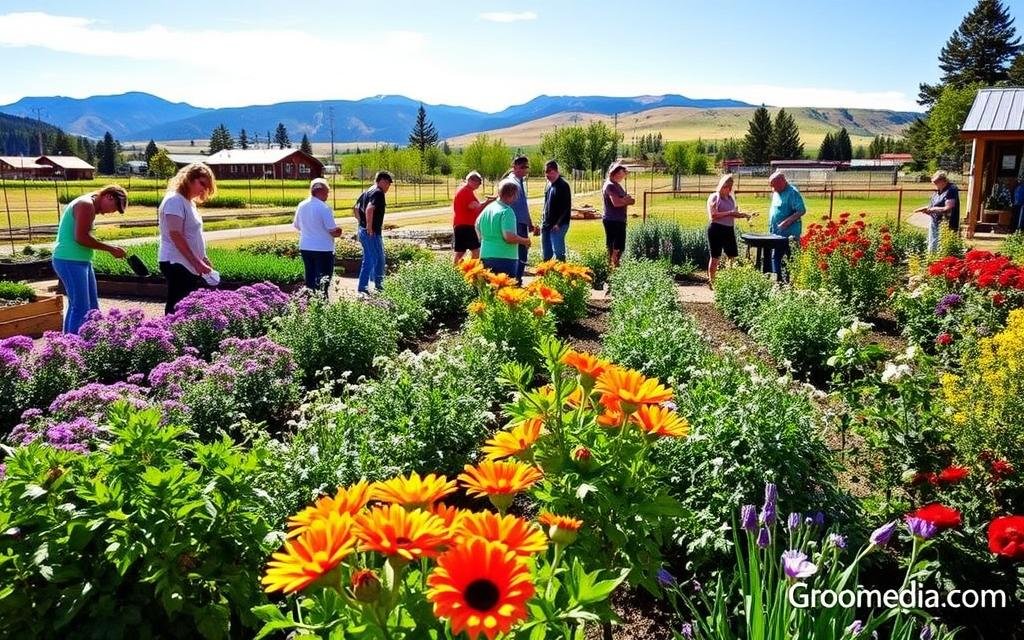Contents
- 1 Table of Contents
- 1.1 Early Life and Roots in Livingston, MT
- 1.2 H2: Establishing Her Own Farm
- 1.3 H2: Innovations in Sustainable Agriculture
- 1.4 H2: Impact on the Local Community
- 1.5 H2: The Role of Technology in Farming
- 1.6 Conclusion
- 1.7 Frequently Asked Questions (FAQ)
- 1.7.1 H2: What crops does Sara Farmer grow on her farm?
- 1.7.2 H3: What sustainable practices does Sara use on her farm?
- 1.7.3 H3: How does Sara Farmer contribute to the local community in Livingston?
- 1.7.4 H3: How has Sara adapted to the challenges of farming in Montana’s climate?
- 1.7.5 H3: What role does technology play in Sara Farmer’s farm?
Table of Contents
Sara Farmer Livingston Mt Livingston, Montana, is known for its breathtaking landscapes, rugged mountain ranges, and pristine rivers. But the true heartbeat of this community comes from its people, particularly those who dedicate their lives to agriculture. Among the many unsung heroes of this picturesque town is Sara Farmer, a local farmer who has made a lasting impact not only through her farming techniques but also through her dedication to community development and environmental sustainability.
Early Life and Roots in Livingston, MT
H2: Childhood and Family Background
Sara Farmer was born and raised in the scenic town of Livingston, located in southwestern Montana. Nestled between the Absaroka-Beartooth Wilderness and the Yellowstone River, the town has a rich agricultural history that has shaped its economy and culture. Sara comes from a long line of farmers, with her great-grandparents having settled in the region in the early 1900s.
Growing up, Sara was surrounded by the beauty of the Montana wilderness and the hard work of farm life. Her family owned a cattle ranch, and from a young age, she learned the value of dedication, resilience, and teamwork. It wasn’t uncommon for Sara to be out in the fields with her father, checking on livestock or helping her mother tend to the vegetable garden. These early experiences instilled in her a deep love for the land and a sense of responsibility for preserving it for future generations.
H3: Education and Early Influences
While Sara’s upbringing was steeped in farm life, she was also keenly aware of the challenges that came with it. The unpredictability of weather, fluctuating market prices, and the physical demands of farming led her to pursue a formal education in agricultural science. After graduating from high school in Livingston, Sara attended Montana State University, where she earned a degree in Agronomy.
During her college years, Sara was exposed to new ideas about sustainable farming practices, soil health, and crop rotation. These concepts would later become the foundation of her approach to farming. She was particularly influenced by the teachings of Dr. Wendy Johnson, a professor of sustainable agriculture, who encouraged Sara to think beyond traditional farming methods and explore ways to farm that would not only benefit her financially but also improve the land’s long-term health.
H2: Establishing Her Own Farm
H3: Starting Out
After graduating from college, Sara returned to Livingston with a vision of creating a farm that combined traditional practices with innovative techniques. In 2005, she took over a portion of her family’s land and officially established “Green Valley Farms.” At first, it was a small operation focused on growing organic vegetables and raising a modest herd of cattle.
Starting out wasn’t easy. Like many new farmers, Sara faced significant financial hurdles, and there were times when she doubted whether her dream would succeed. However, her passion for farming and her belief in sustainable agriculture kept her going. She secured a loan to invest in high-quality seeds, organic fertilizers, and irrigation systems that would improve efficiency. Gradually, her farm began to thrive, attracting attention from local markets and restaurants looking for fresh, locally grown produce.
H4: The Challenges of Small-Scale Farming
Despite her initial success, Sara faced numerous challenges in maintaining a small-scale farm. Weather conditions in Montana can be harsh, with long, cold winters and short growing seasons. To combat these challenges, Sara adopted a variety of techniques to extend her growing season, including using high tunnels and greenhouses to protect her crops from frost and cold temperatures.
Moreover, Sara had to navigate the complex world of farm economics. Competing with larger industrial farms was a constant struggle, and finding markets that appreciated the value of organic, sustainably grown produce required strategic marketing efforts. Sara became a regular at the Livingston Farmers Market, where she not only sold her products but also educated customers about the importance of supporting local farmers and sustainable farming practices.
H2: Innovations in Sustainable Agriculture
H3: Crop Diversity and Soil Health
One of the core principles of Sara’s farming philosophy is crop diversity. Rather than relying on a single crop, Sara rotates a variety of crops each year, including leafy greens, root vegetables, and legumes. This practice improves soil fertility, reduces the need for chemical fertilizers, and helps control pests and diseases naturally.
Sara also incorporates cover crops like clover and alfalfa to maintain soil health during the off-season. These crops protect the soil from erosion and add valuable nutrients back into the earth. By prioritizing soil health, Sara has managed to maintain high levels of productivity without depleting the land’s natural resources.
H4: Water Conservation Techniques
Livingston’s semi-arid climate makes water a precious resource, and Sara is acutely aware of the need to use it wisely. To conserve water, she has implemented drip irrigation systems that deliver water directly to the roots of her plants, minimizing evaporation and ensuring that each crop gets the moisture it needs. In addition, Sara has built retention ponds and swales to capture and store rainwater for use during dry periods.
Her efforts in water conservation have not only reduced her farm’s water consumption but also served as a model for other farmers in the region who face similar challenges.
H3: Organic and Regenerative Practices
Sara is a strong advocate of organic farming and has worked tirelessly to obtain organic certification for her farm. This certification reflects her commitment to avoiding synthetic pesticides, herbicides, and fertilizers, all of which can harm the environment and human health. Instead, she relies on natural methods of pest control, such as introducing beneficial insects and using crop rotation to disrupt pest life cycles.
More recently, Sara has adopted regenerative agriculture practices, which focus on restoring ecosystems and enhancing biodiversity. This approach goes beyond sustainability by actively improving the land, increasing carbon sequestration, and promoting a healthy ecosystem that can withstand climate change.
H2: Impact on the Local Community
H3: Supporting Local Food Systems
In addition to running her farm, Sara has played a crucial role in strengthening the local food system in Livingston. She is a founding member of the “Livingston Farm-to-Table Network,” an organization that connects local farmers with restaurants, grocery stores, and consumers. Through this initiative, Sara has helped to create a thriving market for local produce, ensuring that farmers receive fair prices for their products and that the community has access to fresh, healthy food.
Sara also works closely with local schools, providing them with fresh produce for their cafeterias and educating students about the importance of agriculture. She regularly hosts field trips to her farm, where children can learn about where their food comes from and the work that goes into producing it.
H4: Mentorship and Collaboration
Recognizing the importance of mentorship in the agricultural world, Sara has made it a priority to mentor aspiring farmers. She regularly hosts workshops on sustainable farming techniques, soil health, and water conservation, sharing her knowledge with others in the community.
Sara also believes in the power of collaboration. She has forged partnerships with other local farmers to share resources, ideas, and equipment, reducing costs and improving efficiency for everyone involved. By fostering a sense of community among local farmers, Sara has helped create a supportive environment where farmers can thrive together rather than compete against one another.

H2: The Role of Technology in Farming
H3: Embracing Modern Technology
While Sara remains deeply rooted in traditional farming values, she has also embraced modern technology to enhance her farm’s productivity and sustainability. She uses data-driven tools to monitor soil moisture, crop growth, and weather patterns, allowing her to make informed decisions about when to plant, irrigate, and harvest. These technologies have not only improved her farm’s efficiency but also reduced waste and minimized her environmental impact.
H4: The Future of Farming in Livingston
Sara believes that the future of farming in Livingston and beyond lies in the careful integration of technology with sustainable practices. She envisions a future where farms are able to produce more food with fewer resources, while also protecting the environment and supporting local communities. To achieve this vision, Sara continues to advocate for policies that support small-scale farmers, promote sustainable agriculture, and invest in research and innovation.
Conclusion
Sara Farmer Livingston Mt Sara Farmer’s journey from a young girl growing up on a cattle ranch to a leader in sustainable agriculture is a testament to the power of hard work, innovation, and community. Through her dedication to organic and regenerative farming practices, water conservation, and crop diversity, she has not only built a successful farm but also made a lasting impact on the local food system in Livingston, MT.
Her story serves as an inspiration to aspiring farmers, environmentalists, and anyone who believes in the importance of preserving our natural resources for future generations. As Sara continues to mentor others and advocate for sustainable agriculture, her legacy will undoubtedly continue to shape the future of farming in Montana and beyond.
Frequently Asked Questions (FAQ)
H2: What crops does Sara Farmer grow on her farm?
Sara grows a variety of organic vegetables, including leafy greens, root vegetables, legumes, and cover crops like clover and alfalfa to promote soil health.
H3: What sustainable practices does Sara use on her farm?
Sara employs a range of sustainable practices, including crop rotation, organic farming techniques, water conservation methods like drip irrigation, and regenerative agriculture to enhance biodiversity and improve soil health.
H3: How does Sara Farmer contribute to the local community in Livingston?
Sara supports the local food system by providing fresh, organic produce to local markets, schools, and restaurants. She also mentors aspiring farmers, hosts educational workshops, and participates in the Livingston Farm-to-Table Network to strengthen connections between farmers and consumers.
H3: How has Sara adapted to the challenges of farming in Montana’s climate?
To overcome the challenges of Montana’s short growing season and harsh winters, Sara uses high tunnels, greenhouses, and drip irrigation to extend her growing season and conserve water. She also rotates crops and incorporates cover crops to protect soil health.
H3: What role does technology play in Sara Farmer’s farm?
Sara uses modern technologies such as soil moisture sensors, crop monitoring tools, and weather data to make informed decisions about planting, irrigation, and harvesting, improving both efficiency and sustainability.




